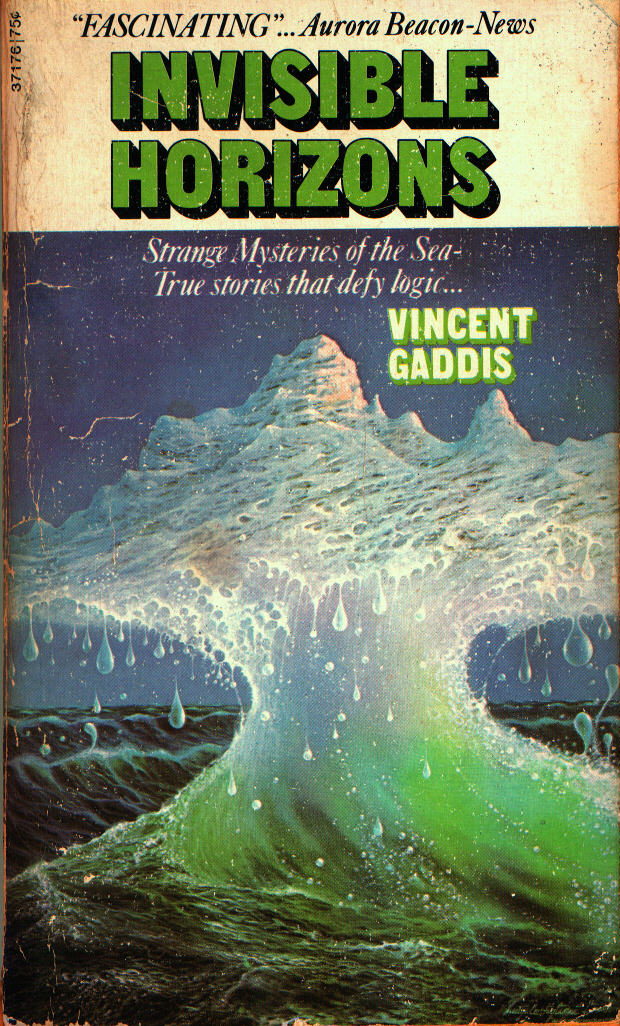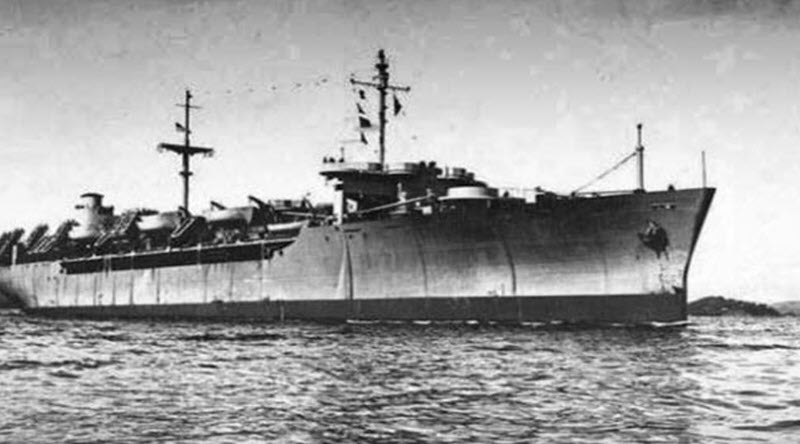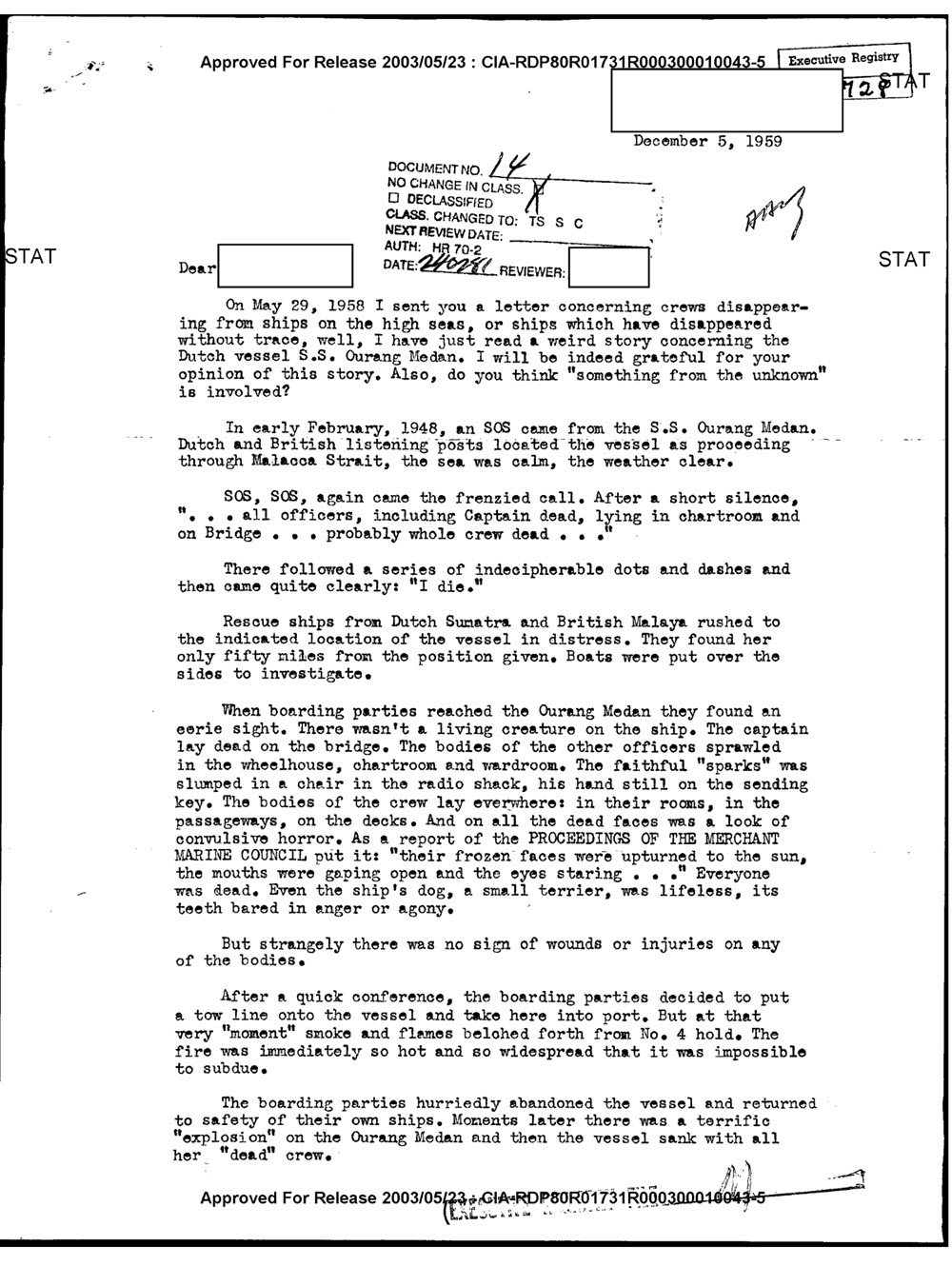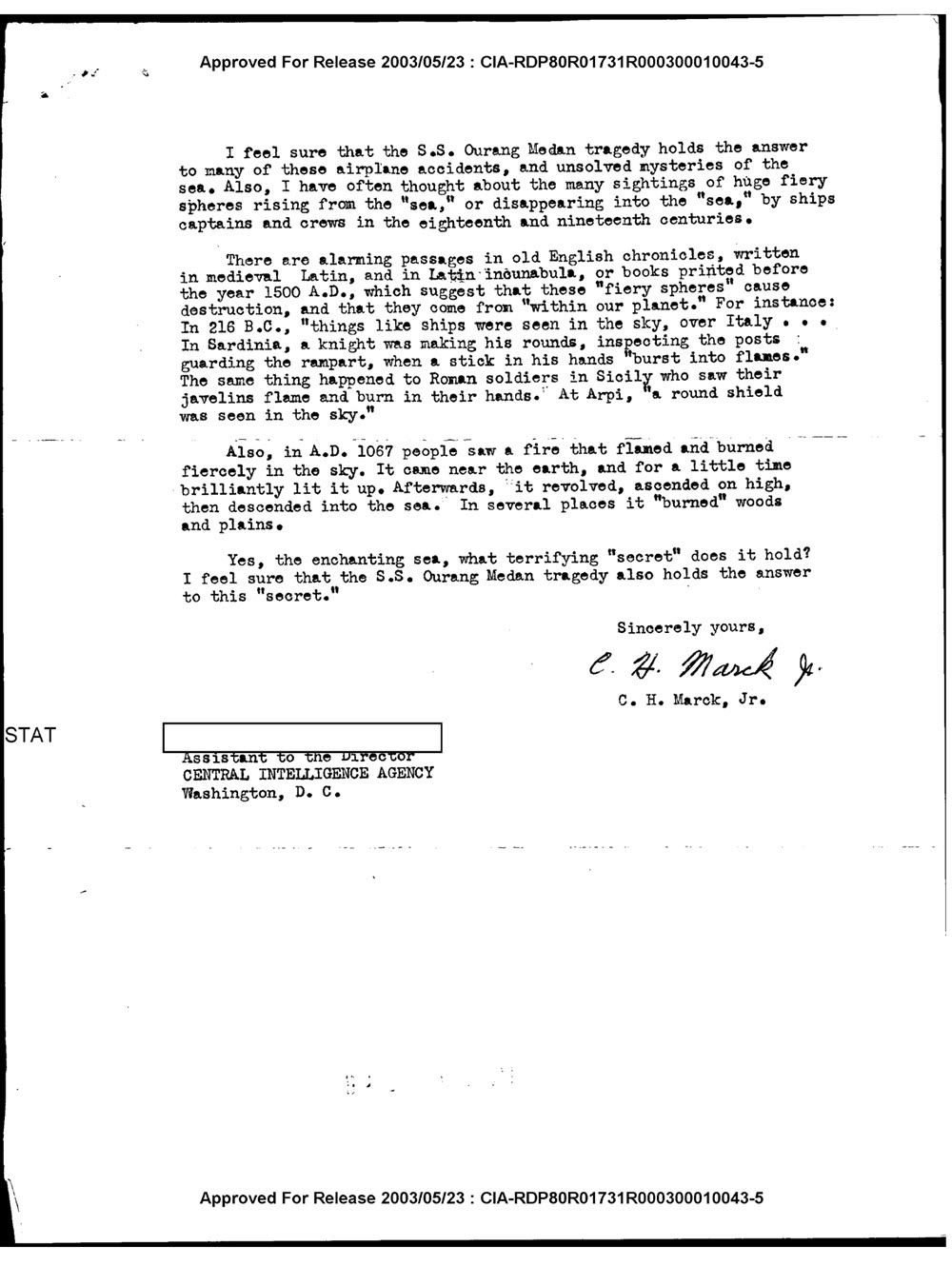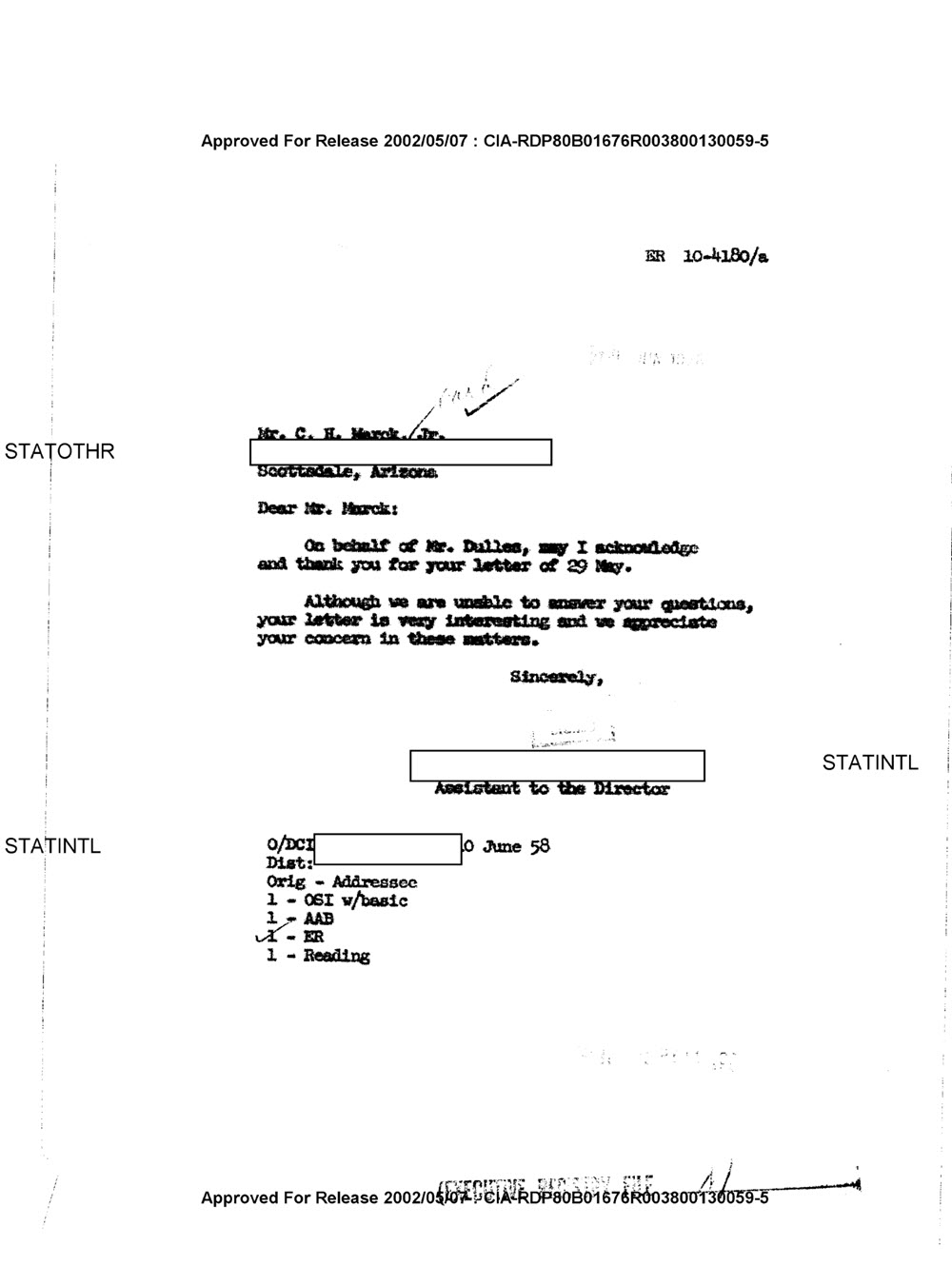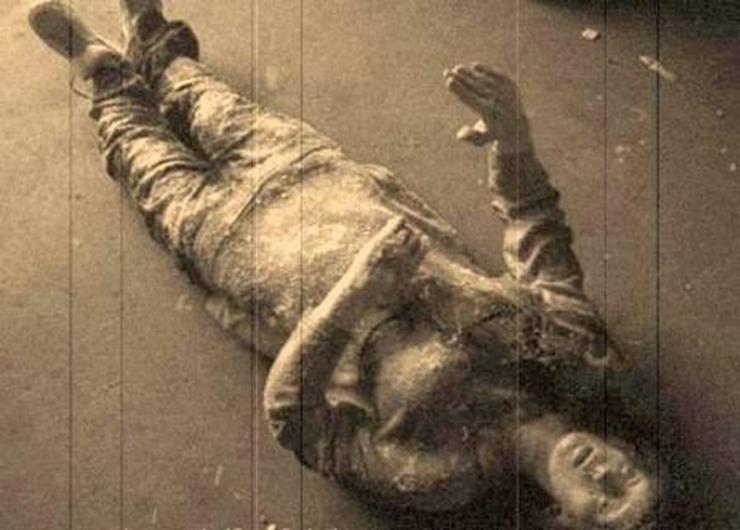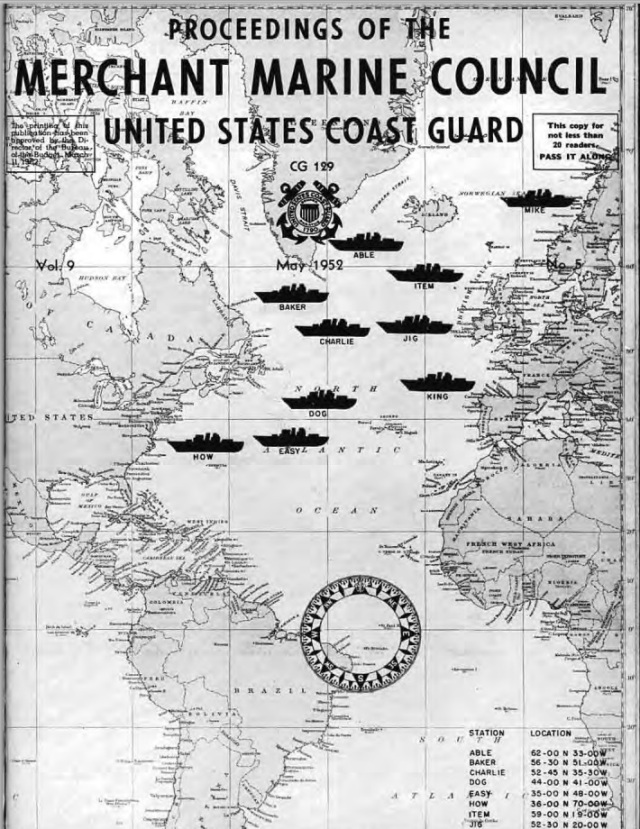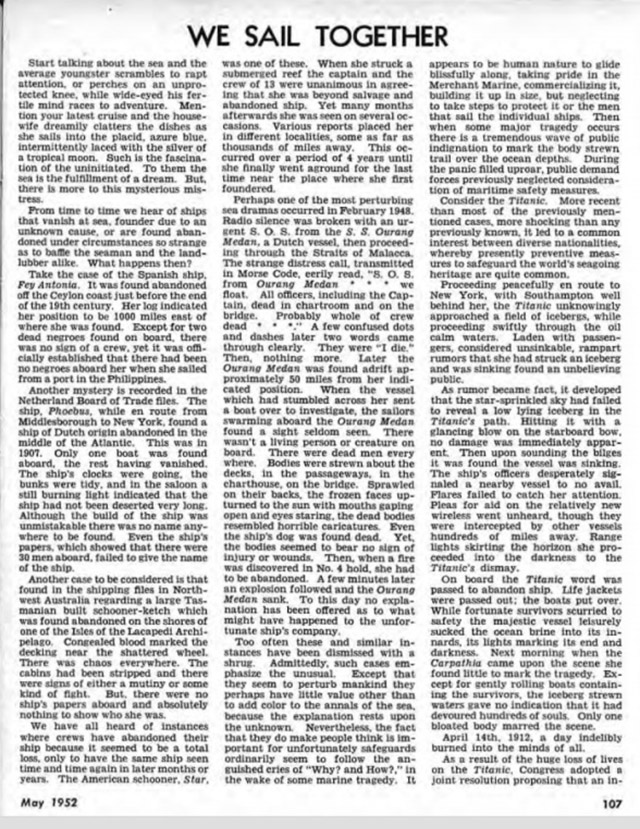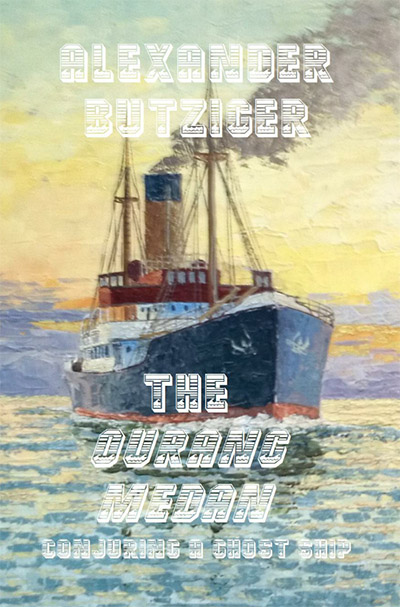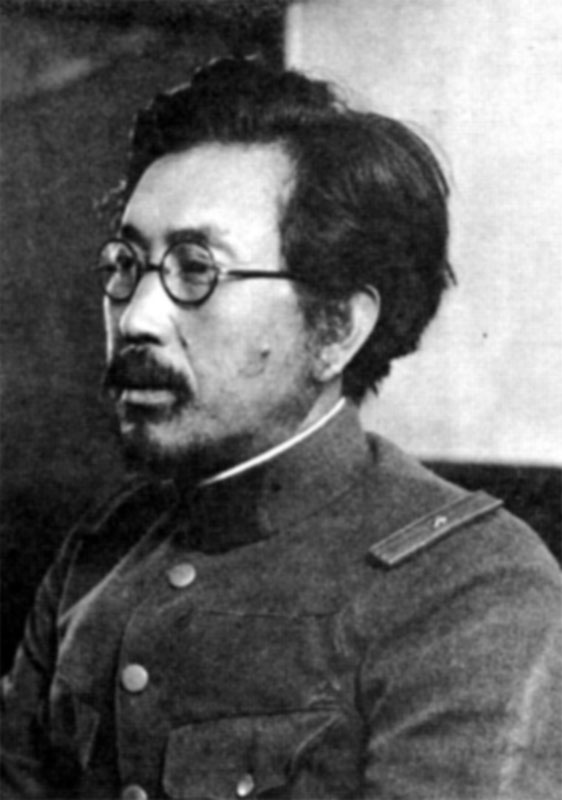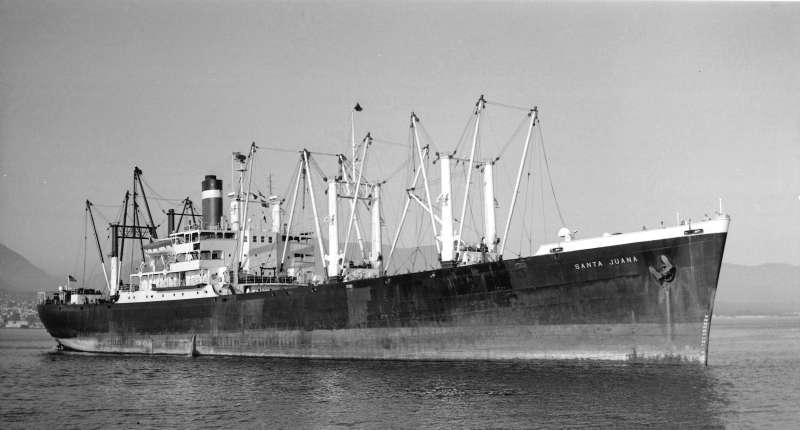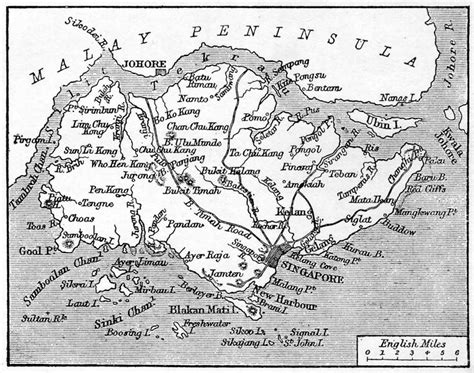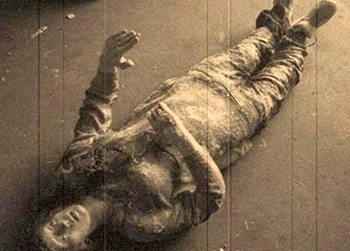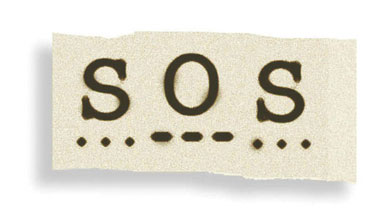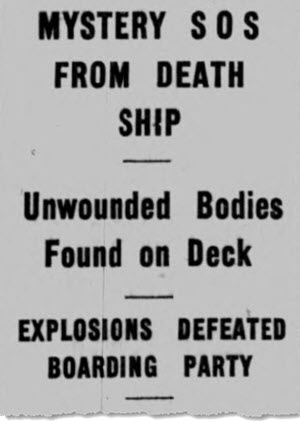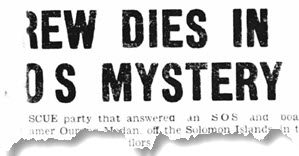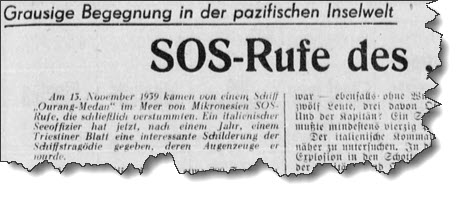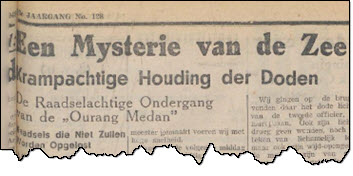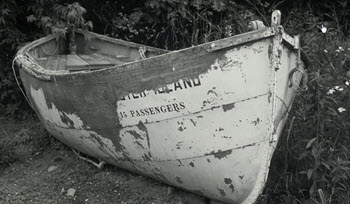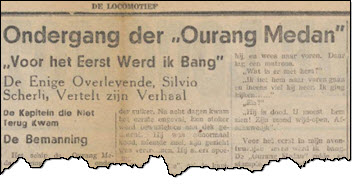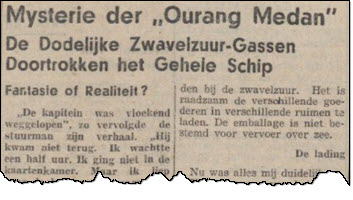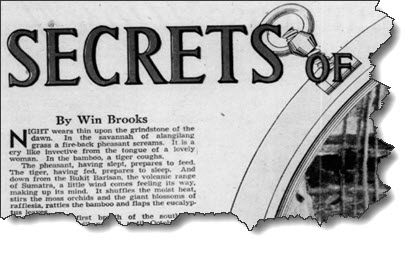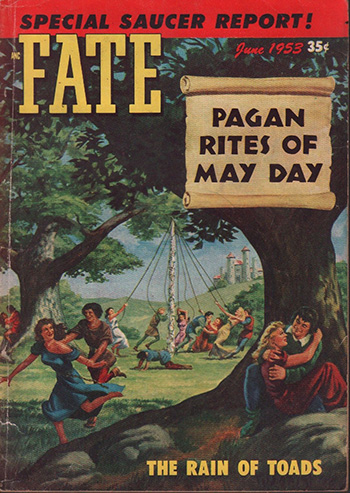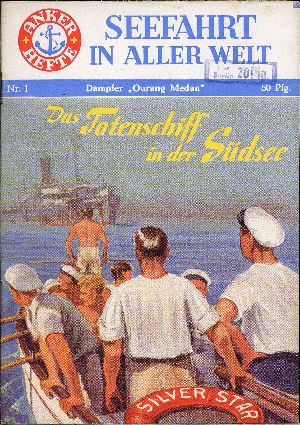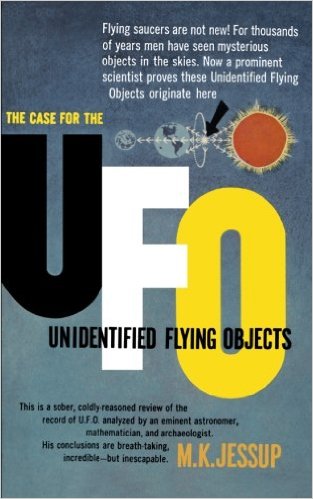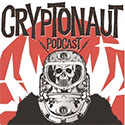
In 1947 the Dutch Freighter SS Ourang Medan sent a cryptic SOS in Morse code;
“All Officers, including the Captain, are dead. Lying in chartroom and bridge. Possibly whole crew dead.” This communication was followed by a burst of indecipherable Morse code, then a final, grim message: “I die.”
In Vincent Gaddis’s 1965 book “Invisible Horizons: Strange Mysteries of the Sea-True stories that defy logic…”, I first encountered the enigmatic tale of the SS Ourang Medan. Years later, my curiosity drew me back to this perplexing legend, eager to uncover any new revelations time might have unearthed.
The SS Ourang Medan, infamous for its haunting distress signal, became the center of a maritime mystery. The last known position of the ship was pinpointed using radio directional equipment, prompting the American merchant vessel Silver Star, nearly a day’s journey away, to embark on a rescue mission. However, upon arrival, the Ourang Medan was found adrift, eerily off-course by about 50 miles.
What the Silver Star crew discovered upon boarding was a scene straight from a nightmare: the decks strewn with the crew’s corpses, each face contorted in unspeakable horror, their bodies poised as if warding off an unseen terror. Even the ship’s dog lay lifeless, frozen mid-snarl. The captain was found on the bridge, with other officers in the wheelhouse and chart room. The young radio operator, likely the one who sent the distress signal, was dead in the wireless room, still wearing his earphones, his hand on the key. The engineering crew met a similar fate at their posts. In total, 22 crew members were found dead, each sharing the same expression of terror.
Intriguingly, a lifeboat was missing, suggesting that perhaps some crew members might have escaped the unknown horror that overtook the Ourang Medan. Yet, there was no trace of this lifeboat, nor were any survivors ever found. The mystery of what happened to these men remains unsolved, shrouded in the deep, unfathomable mysteries of the sea or was it really…
SS Ourang Medan Ship of the Dead
The rescue party noticed several things that seemed strange. The local temperature was in excess of 110°F, but members of the rescue party felt an ominous chill. All of the victims had suffered from something, but none had any injuries when examined. They also seemed to be decaying quicker than they should be. They decided to toe the ship to the nearest port and began making preparations. Just as salvage operations began they noticed ominous billows of smoke pouring out from Number 4 hold. Quickly they cut the ship loose just as the Ourang Medan exploded with enough force to briefly lift it out of the water before rolling over and sinking… disappearing for good.
Like The Philadelphia Experiment, the story of the SS Ourang Medan has become something of a legend over all these 75+ years, with new “facts” added here and there, and more surprisingly reported multiple times in history.
In the June, 1953 (Volume 6, No 6) issue of Fate Magazine, Frank Edwards and Robert V. Hulse wrote an article “Death At Sea” that really brought the basics of the story to light. Authors such as Morris K. Jessup quote the article and speculate in his 1955 book “The Case for the UFO” (Made famous by it’s link to The Philadelphia Experiment and the Navy’s reproduction of it as The Varo Edition) that the crew might have been attacked by UFO’s or paranormal forces prior to their deaths. Circumstantial evidence cited by these authors includes the apparent absence of a natural cause of death, the reportedly terrified expressions on the faces of the deceased, and rumors that some of the dead were “pointing” towards an unknown enemy.
Strangely there are letters in the CIA Archives, In December 1959, C.H. Marck Jr. C.H. of Scottsdale, Arizona sent a letter to the assistant to the Director of the U.S.’s Central Intelligence Agency (C.I.A.) Allen Dulles. The letter was classified as “top secret” by the C.I.A. and would not be released to the public until May 5, 2003. While the letter and its sender were known, the person to whom Marck wrote the letter remains redacted by the C.I.A. to this day. This would not be the first time Marck wrote into the CIA, and there are other letters in their archives from him. Many sites report this as if Marck worked for the CIA, which he did not. I found the letter in the CIA Archives, as well as the response below;
“Sprawled on their backs, the frozen faces upturned to the sun with mouths gaping open and eyes staring, the dead bodies resembled horrible caricatures“ [1]
The Story of the SS Ourang Medan from Various Sources
On June 27, 1947, in the South Seas The SS Ourang Medan sent an SOS call and asked at the same time for a doctor to be sent. This combination of two emergency calls was considered very unusual. The emergency call was intercepted both by the steamer City of Baltimore and by the American steamboat Silver Star. After the response of the Silver Star the Ourang Medan gave in a renewed radio message their position with 179 degrees West and 20 degrees South [Between the named position and the one mentioned in the original more than 5000 km.] and also stated that the third officer was lying dead on the bridge and the ship’s captain and engineer were also dead and probably the entire crew. During the radio call, the connection broke off. However, the unknown radio operator once again managed to contact the Silver Star with the words “I die”.
At the time of the SOS, the Silver Star was a good 210 nautical miles southeast of the position reported by the Ourang Medan, a good 19 hours sail from the stricken, which according to their own information was drifting. The Silver Star immediately took a new course. All attempts to make further radio contact failed. The City of Baltimore, which had a doctor on board, continued in communications with the Silver Star as it was located over 800 nautical miles from the distressed vessel’s reported location.
The next day, June 28, 1947, around 9 o’clock local time, the Ourang Medan was sighted. The chimney showed no smoke, and the steamer did not change its position. A flag was not set. The Silver Star circled the stricken vessel at a distance of several hundred meters and sounded the ship’s siren several times, but there were no people visible on board the stricken vessel. The Ourang Medan had a slight list to starboard, but no visible damage. The crew of the Silver Star suspected that the list was due to poorly loaded cargo or uneven coal consumption. As the steamer circled, the Silver Star noted that a lifeboat was missing on the starboard side. The lift for the missing boat with lines still hung from the side of the damaged vessel, which made an absolutely seaworthy impression.
Since calling with a megaphone did not cause a response, the Silver Star launched a boat with the first officer and nine men to investigate the Ourang Medan. Four men climbed over the Taligen runners and began to look at the ship. Due to the size of the steamer, the Americans estimated that a good 40 man crew would have to be on the ship. Already on the upper deck, the men of the Silver Star found the first bodies. The crew members of Ourang Medan appeared to have died in great agony but showed no external injuries. No traces of blood or struggle. The ship’s staff all seemed to be Asians. In the radio room the radio operator, who had made contact with them, was also found dead. The hope of finding the steamer’s log when searching the bridge and the captain’s cabin did not materialize. All ship’s papers seemed to have taken by the crew of the missing lifeboat.
Early on, the four men of the Silver Star perceived a peculiar smell on board. Suddenly smoke was detected, suggesting a fire in the ship.
The first officer immediately ordered everyone to leave the stricken vessel. When the crew returning had covered about half the distance to the Silver Star, there were several heavy explosions aboard the Ourang Medan, which did not destroy the ship but only set it on fire. For hours, the Silver Star watched the burning steamer, which finally lay on its side and sank beneath the surface. The sea depth is at this point about 5000 meters.
The captain of the Silver Star had no explanation for the incident but suspected that the Ourang Medan had loaded chemicals and ammunition and/or explosives. He made a record of the incident in the logbook to report to the authorities on his return home.
On July 12, 1947, a good three weeks later, a lifeboat was washed ashore on the island of Taongi, which is part of the Marshall Islands. Of the seven passengers, six had already died; the last surviving person was cared for by a missionary. The person allegedly was the Second Officer of Ourang Medan, called Jerry Rabbit. According to his information, Ourang Medan had arrived in Ballast Shanghai on June 7, 1947, where Rabbit was recruited. The ship’s command of the steamer, however, strangely enough, did not want to see any papers from him. The now second officer suspected that a large proportion of the crew had been recruited in a similar manner. According to Rabbits information, it was an originally Chinese steamer, which had possibly been used for cargo or as a troop transport.
In Shanghai, allegedly 7000 boxes of unknown materials were taken over at night. The ship sailed south on the morning of June 9, 1947. In a small harbor, about 80 nautical miles south of Shanghai, a good 8000 boxes were taken on board again. Rabbit suspected that the entire cargo was contraband. The destination of the Ourang Medan was allegedly the coast of Costa Rica, where the cargo at sea should be handed over to another ship.
The course of the steamer was designed to avoid the usual shipping routes and led through the Marianas and Karolinen islands. After ten days, probably around June 21, 1947, the stokers began to fall ill; a stoker died immediately. The captain stated as a cause of death heat stroke, which the second officer considered unlikely, even though in the boiler room in view of the tropical climate extremely high temperatures prevailed. A few days later, the entire machine crew began to fall ill and complained of severe stomach pains or stomach cramps. Looking through the ship’s papers, Rabbit discovered that Ourang Medan had loaded 15,000 boxes of sulfuric acid and cyanide and 20 canisters of nitroglycerine. Rabbit guessed that some of the boxes had become leaky and that fumes had formed. Since the captain refused to make an emergency call, Rabbit, together with six crew members on their own set off a lifeboat and moved away from the now driving steamer, as the ship’s engine stopped.
Since the lifeboat was equipped with neither water or provisions, the six other boat occupants of the lifeboat died within a few days due to the intense heat. Even Jerry Rabbit died of exhaustion a few days after his rescue.
It is unclear whether and how the Silver Star transmitted the story to the authorities or the shipping company when they returned to the United States.
“We Sail Together”
The story of the SS Ourang Medan as reported in the Proceedings of the Merchant Marine Council, May 9, 1952;
“Perhaps one of the moat perturbing sea dramas occurred in February 1948. Radio silence was broken with an urgent S. O. S. from the S. S. Ourang Medan, a Dutch vessel, then proceeding through the Straits of Malacca The strange distress call, transmitted In Morse Code, eerily read. “S O. S. from Ourang Medan • • • we float. All officers, including the Captain dead In chartroom and on the bridge. Probably whole of crew dead • • A few confused dots and dashes later two words came through clearly They were “I die “ Then, nothing more Later the Ourang Medan was found adrift approximately 50 miles from her Indicated position. When the vessel which had stumbled across her sent a boat over to Investigate, the sailors swarming aboard the Ourano Medan found a sight seldom seen. There wasn’t a living person or creature on board. There were dead men everywhere. Bodies were strewn about the decks. In the passageways. In the charthouse. on the bridge. Sprawled on their backs, the frozen faces upturned to the sun with mouths gaping open and eyes staring, the dead bodies resembled horrible caricatures Even the ship’s dog was found dead Yet. the bodies seemed lo bear no sign of Injury or wounds. Then, when a fire was discovered In No. 4 bold, she had to be abandoned. A few minutes later an explosion followed and the Ourano Medan sank. To this day no explanation has been offered as to what might have happened to the unfortunate ship’s company”
It Happened When? in 1947?, in 1948?, Or…
Since a lot of this story has the date of the incident in question, I started by looking through some books as early as 1955, which provided the date as of February 1948. I found the first official mention of the incident was in May of 1952 by the United States Coast Guard in the “Proceedings of the Merchant Marine Counsel.” I then went through newspaper archives to see when stories first started to appear. The first newspaper article appeared in the Dutch-Indonesian newspaper “The Locomotive, or De locomotief: Samarangsch handelsen advertentie-blad” in installments on; February 3rd, February 28th, and March 13th, 1948. Searching North American archives of 11 articles, the earliest I could find was;
- The San Francisco Examiner (San Francisco, California), 03 Oct 1948, Sun, Page 33
- Very Short Article basically announcing the “Secrets of the Sea”
- This same short piece also appeared in The Atlanta Constitution on the same day
- The Atlanta Constitution (Atlanta. Georgia) , 10 Oct 1948, Sun, Page 24 & 25
- Article Titled “Secrets of the Sea”
- The San Francisco Examiner (San Francisco, California), 10 Oct 1948, Sun, Page 24 & 25
- Same two page spread as the Atlanta
- The Windsor Star (Windsor, Ontario, Canada), 09 Aug 1969, Sat, Page 32
- I only included this one as even the city I work in reported on it.
The rest were all past the 1960’s repeating the same “facts.”
So after much reading all I could find is “At some point around June 1947” and other, later versions of the story conclude that the date was actually February 1948. Gee that sounds pretty concrete case of the date solved? Everyone is pretty sure it happened sometime in 1947/48, strangely when searching the British Newspaper Archives I find these very interesting articles, take note of the dates;
- Yorkshire Evening Post (London, England), Thursday, 21 November 1940, Page 5
- Article Titled “Mystery SOS From Death Ship”
- “Explosions were repeated. Soon nothing was left of the Ourang Medan but a blazing hulk. ‘ The next day the fire burned it self out and the steamer went under her secret with her The Ourang Medan had sent out in SOS and the message.. Send doctor—urgent …“
- “SOS from the steamship Ourang Medan. Beg ships with short wave wireless get touch doctor. our short wave set we relayed the call for help. Medical stations Germany. Rome and France replied We informed the Ourang Medan and asked her transmit her request …“
- Daily Mirror (London, England), Friday, 22 November 1940, Page 11
- Article Titled “Crew Dies in SOS Mystery”
- Same basic account as the Yorkshire, but more brief of a article
- Hampshire Telegraph (Hampshire, England), Friday 29 November 1940, Page 8
- Article Titled “Story of Weird Sea Tragedy”
Clearly this ship burned and sank some seven years earlier in 1940, why are so many articles so sure it was 1947/48? Many details are the same as the 1948 version, with a few notable exceptions;
- There’s nothing of the strange details of how the dead crew looked.
- The name of the ship that found the Ourang Medan is never mentioned in either the 1940 or 1948 version of the story. The detail of the Silver Star was simply “added” at some point after.
- The location has changed again. In this first report (1940), the ship was found south-east of the Solomon Islands, then in 1948 it’s reported as 400 nautical miles (740 km) southeast of the Marshall Islands.
- The SOS messages that make up the core of the mystery are markedly different. This is very interesting, the first says “SOS from the steamship Ourang Medan. Beg ships with shortwave wireless get touch doctor. Urgent.” The second “Probable second officer dead. Other members crew also killed. Disregard medical consultation. SOS urgent assistance warship.” The article says the ship then gave her position and ended with the final, incomplete, message “crew has…”
The Locomotive stated clearly that the entirety of its information came from Silvio Scherli. The three part series ends with a very skeptical
“This is the last part of our story about the mystery of the Ourang Medan. We must repeat that we don’t have any other data on this ‘mystery of the sea’. Nor can we answer the many unanswered questions in the story. It may seem obvious that this is a thrilling romance of the sea. On the other hand, the author, Silvio Scherli, assures us of the authenticity of the story.”
So what can we learn from all the newspaper stories in the end? I think Estelle Hargraves conclusions are well founded;
“Trieste is the crucial link, as we can therefore assume that Silvio Scherli of Trieste is the same person involved in this story [1940], as he was in the later version [1948.] If he was the source of the 1940 story, then there’s simply no way he could have truthfully reported on the matter in 1948, describing it as a new incident. It could be the case that there was another source of the story in Trieste in 1940 – perhaps someone who told it to Silvio? If the story came from Indonesia, say, then the sources could be numerous. But Trieste seems too specific, and too distant, to have many witnesses or other people who knew about this story from far away. The Associated Press archives, or other newspaper stories which blossomed from their reports, might be the key here.” [2]
So who was Silvio Scherli? Details are slim, but it seems that he was told the account while living in Triest by a missionary. This missionary, in turn, heard it from the last surviving member of the Ourang Medan’s crew a German man who had related the tale. He said an “unregistered cargo” had leaked chemical fumes and overcome the crew. His lifeboat had made it to “Toangi Island in the Marshalls”.
As it turns out the earliest date reported for the incident is November 13th, 1939! Clearly before the Silver Star was even built, and some 8~9 years before other accounts. So was the ship now reported to sink two or three times? I’m sure I am not the only one losing count…
“I found a copy of the Vichy French magazine Sept-Jours (#45, September 7, 1941) that had the more or less complete story of the Ourang Medan in it (p. 9, “Après Vingt Mois — Le Mystère de l’ ‘Ourang-Medan’ Est Éclairci,” i.e., “After Twenty Months, the Mystery of the Ourang Medan Is Solved”). This article, in turn, refers to an earlier article on the Ourang Medan in an earlier issue of the same magazine (#13, December 29, 1940). According to Sept-Jours, the Ourang Medan incident took place on November 13, 1939.” ~ Alexander Butziger [3]
Just What Was The Ship Transporting?
Interestingly what it was transporting may clarify much of the mystery. Possible lethal and highly illegal toxic chemicals, when accidentally mixed caused the crew to die, and ultimately the ship to explode. Considering the Geneva Protocol of 1925, ratified by 33 nations, explicitly banned all chemical weapons, transporting such substances would have required utmost secrecy. This covert operation likely involved an unregistered ship manned by a foreign crew, with all voyage records either concealed or altered to protect government interests… You had to know a good old-fashioned government conspiracy was coming to help keep the Legend alive.
Marine historian Roy Bainton after much research believes the vessel may of been involved in smuggling operations of hazardous cargo. (such as nitroglycerin and potassium cyanide, or even various nerve agents.) If sea water breached the Ourang Medan’s hold, its reaction with these deadly materials may have released toxic gases that could’ve caused poisoning or asphyxiation of the crew. These chemicals A fire and subsequent explosion could have also taken place.[4]
Biological weapons manufactured by Japanese scientists as the result of insidious experiments beyond even what the Nazi regime would have undertaken could have been smuggled out of Japan. Known as Unit 731, it was designed to be a secret research and development unit meant to create the most dangerous chemical and biological weapons to help to win the war. Unit 731 was formed sometime in 1932 by the Japanese bacteriologist named Shirō Ishii, who conducted terrible experiments on helpless Australian, American, Russian, Chinese, and British prisoners, some of the worst war crimes ever committed during WW II.
The gas “..could penetrate the filters of all known gas masks and contact with even small lingering quantities had fatal effects…” ~ Albert Speer [5]
Shiro Ishii, Commander of Unit 731
Possible Explanations from Scientific to Silly
- Methane, a deathly greenhouse gas, can be found naturally escaping the ocean seabed forming huge gas bubbles that could have enveloped the ship.
- Sound scientific explanation of how the crew could have been killed with no sign of harm and how the ship may have exploded when the gases mixed with the boiler room. Sounds good on paper but seems the two events, the death of the crew, and the arrival of the rescue ship hrs later were too far apart to make this sound plausible.
- Vincent Gaddis in 1965 put forth the theory that an undetected smoldering fire, or malfunction in the ship’s boiler system might have been responsible for the shipwreck. Escaping carbon monoxide may have caused the deaths of all aboard, with the fire slowly getting out of control, leading to the vessel’s ultimate destruction.
- The problem with this theory is that the ship is not an enclosed space. Fumes could’ve simply escaped into the atmosphere, and lives of the crew working the upper decks of the ship would’ve been spared. Further with this cause of death I need to do more research but think there is visual indicators (color of skin) that are not consistent with the story.
- Improperly stored or secured Hazardous cargo. (such as nitroglycerin and potassium cyanide, or even various nerve agents.)
- If sea water breached the hold, its reaction with these deadly chemicals may have released toxic gases that could’ve caused the asphyxiation of the crew. Further with these chemicals interacting and possible fire a subsequent explosion could have also taken place.
- Pirates
- There are theories claiming that pirates invaded the Ourang Medan and killed everyone on board. Problems with this theory is clear, it doesn’t explain some accounts saying that there were no visible wounds on the victims’ bodies. It also does not explain the SOS messages, as nothing is said about being attacked or boarded. However it does fit with the Strait of Malacca’s long history with piracy.
- Aliens / UFO
- Morris Jessup in 1955 put forth the theory that the crew might have been attacked by UFO’s prior to their deaths, given the apparent absence of a natural cause, the reportedly terrified expressions on the faces of the deceased, and rumors that some of the dead were “pointing” towards an unknown enemy.
- Ghosts / Paranormal activity
- The rescue team reported as soon as they entered the hull of the ship, despite it being 110°F outside, they felt a cold chill. This is usually reported in cases of Paranormal activity. That coupled with the frightened expressions on the crew’s faces and lack of any cause, yep what’s a Ghost Ship story without ghosts.
- Oh wait I read a theory of Ghost Pirates
- And YES we have arrived at the Silly.
I also have some questions about the description of the Explosion, how it happened with such force the ship rose out of the water then crashed back down and sunk. Not sure on the physics of that but at this hr that is research for another day.
Just the “Facts”
The factual accuracy and even the ship’s existence, are unconfirmed to this day. Details of the vessel’s construction and history, remain unknown. Searches for any official registration in Lloyd’s Shipping registers, or accident investigation records in the Dictionary of Disasters at Sea, 1824-1962 have proven unsuccessful by several authors in the past. Researchers have contacted the United Kingdom Admiralty, the Registrar of Shipping and Seamen and the National Maritime Museum in Greenwich, Maritime Authority in Singapore, searched Dutch Shipping records in Amsterdam all to no avail.
“Saga magazine even sent me to Amsterdam’s Maritime Museum to track the Ourang Medan down. The archives yielded nothing.” ~ Roy Bainton [2a]
There are no original/verified pictures of the SS Ourang Medan, or the incident. All the images you see in articles and even the one at the beginning of this page are only representations of what the ship would of looked like. Alexander Butziger goes over each of the ten published photos in excellent detail in his chapter “Chapter Ten: Pics and It Did Happen?” [3]
The rescue ship the Silver Star is another point where most researchers have said it simply did not exist. However it was originally christened “Santa Cecilia” by the Grace Line (W. R. Grace & Co.), and later renamed the “Silver Star” when the United States Maritime Commission “drafted” it in 1946. In 1947 it had been reacquired by the Grace Line shipping company who renamed the vessel the “Santa Juana” till it was scraped in 1971. So, in reality, it was only named the “Silver Star” for a short period. Repeated attempts by researchers to get details from Grace Lines in New York of the Silver Star crew list and logbook had been met with a strange silence.
Santa Juana (Ex Silver Star) General Cargo Ships Built In 1940
I spent a few hours searching newspaper archives and really not a single thing could be found for a ship called “Silver Star” which is odd as if you run other ships from the 1940’s you will find all sorts of stuff, launch announcements, deployment announcements, stories in general… I can find articles for the Grace Line shipping company, but nothing of the ship in question. Interestingly I found an article that talks about converting ships from the Grace Line to Troop Transport ships by the Maritime Commission however this was on 12 Aug, 1948. I did find normal shipping news for the “Santa Juana” in 1947, launch announcements for the “Santa Cecilia” (January 24th, 1946) but again nothing at all for the “Silver Star.” however after some more searching I did find that in fact the Silver Star is listed on Grace Line (W. R. Grace & Co.) ship list as the Santa Cecilia #3.
I can also find references on United States Maritime Commission page. I like facts I can verify, so yep I can say there was a ship called the “Silver Star.” Did it run a rescue mission to the SS Ourang Medan.. no records can be found. Speaking of no records, I searched the national archives, ship war diaries, etc. and not one report of the “Silver Star” there was convoy reports and such for the SS Santa Cecilia, but not a single mention of a ship called the “Silver Star” ever being in a convoy or other actions which I find strange.
Professor Theodor Siersdorfer of Essen in Germany spent over 50 years researching the story of the SS Ourang Medan. Siersdorfer was the first to mention the names of the American ships that originally went to render aid to the Ourang Medan. He refers anyone interested in their own research to a 32-page booklet written in German called “Das Totenschiffin der Südsee” (translates to “The ship of the dead in the South Sea“) by Otto Mielke, written in 1954. The booklet contains a lot about the ship, the route it took, the cargo it carried (potassium cyanide and nitroglycerin), and interestingly the name of the Captain. Otto also states the incident happened in June of 1947, again no two accounts can agree on a date.
A lot of time has been spent by researchers trying to link the Silver Star in 1947 in some way by position, logbooks, or anything for that matter.. No crew members of the Silver Star ever shared any information with the news media, nothing, and there never will be. Why you may ask? Well the bottom line is if the SS Ourang Medan existed it was fist reported sunk in 1939, not 1947/48 and if this is true, there will be no logbook entries of a harrowing rescue and recovery attempt by the Silver Star as the ship was not even constructed yet.
“my theory is that Silvio didn’t get quite the notoriety he sought the first time round, the news buried by the events of the ongoing world war. Perhaps he sat on it until the war ended, world news quietened down, and tried again. But maybe there’s more still to be found in how this story got off the ground.” ~ Estelle Hargraves
Never A Straight Story
If five people witnessed, say, a car crash, they would relate similar stories and basic facts would remain unaltered (The sky was blue, the car was green, it happened in November, everyone died, etc.)
Here we have no one agreeing on any “facts”;
- The date of the SOS message (1939, 1940,1947,1948)
- What the SOS message said (send doctor, everyone’s dead)
- Where it happened (200 miles southwest & southeast of the Solomon Islands, Straits of Malacca, 250 miles from the Marshall Islands)
- Where the fire started (some say #4 boiler, some say #2)
- If there were survivors (some yes, some no)
- if there were survivors where did they come ashore (Fiji or Marshall Islands)
- What ship came to the rescue (from destroyers to freighters, from different places.. they sort of look Vastly different.)
This legend much like the Philadelphia Experiment I feel will never die. In 2019 it has been turned into a game: “The Man of Medan“ is the first game in The Dark Pictures Anthology, bringing supernatural horror on board a ghost-ship adrift in the South Pacific.
Investigation continues… This timeline below is presently under construction some dates to add…
PLEASE READ
This site, unlike most these days, delivers a pleasant browsing experience free from intrusive elements (devoid of bothersome popups, distracting or distasteful sidebar ads, excessive and irrelevant images, and misleading clickbait) that disrupts your reading, focus or enjoyment.
To support our commitment to a seamless user experience, we kindly request your contribution to help keep it that way.
All donations, no matter how large or small, are hugely appreciated.
THANK-YOU!
More on Jessup’s Book “The Case for the UFO”
Late in 1955 a copy of Mr. Jessup’s book, “The Case for the UFO” was mailed to Admiral N. Furth, Chief of the Office of Naval Research, with a mysterious “HAPPY EASTER” written on the manila envelope. When examined, the book contained several hundred notes written by what seemed, three different people in three different colors of ink (blue, blue-violet, and blue-green.) The comments were written on the top, bottom, and edges of the printed text, and referenced underlined passages in the book.
The unknown commentators implied knowledge of UFO’s and their propulsion systems, and of at least two different alien races. Some of the comments scrawled in the book contained terms such as “mother ship, home-fleet, Great ark, great bombardment, great war, force-fields, deep freezes, undersea buildings, scout ships, magnetic and gravity fields, vortices, dematerialization, magnetic net, etc.”
This was reproduced by the Officers and became know as The Varo Edition. The Varo Edition contained close to two hundred retyped, mimeographed pages including the Carl M. Allen letters, and a special three page introduction written by the Office of Naval Research. There were approximately 127 copies produced and circulated by the ONR Officers as strange as it sounds.
Below is a section from the Varo Edition on the SS Ourang Medan that also drew some interest to the story. The comments in blue were hand written.
Excerpt from The Varo Edtion of the Case for the UFO
by Morris K. Jessup
SOS, SOS—came the distress call from the Dutch vessel S.S.Ourang Medan. Dutch and British listening posts located the vessel as proceeding through the straits of Malacca. It was early February 1948, the sea calm, the weather clear.
SOS, SOS, again came the frenzied call. After a short silence, “…all officers, including Captain dead, lying in chartroom and on Bridge… probably whole crew dead…”
There followed a series of indecipherable dots and dashes and then came quite clearly: “I die.” And after that only an ominous silence.
Rescue ships from Dutch Sumatra and British Malaya rushed to the indicated location of the vessel in distress. They found her only fifty miles from the position given. Boats were put over the sides to investigate.
“Medan” was MOVED. RADIO DIRECTIONALFINDERS
ARE TOO ACCURATE & SHIPS TOO SLOW TO MOVE THAT
FAR IN SO LITTLE TIME.
When boarding parties reached the Ourang Medan they found an eerie sight. There wasn’t a living creature on the ship. The captain lay dead on the bridge. The bodies of the other officers sprawled in the wheelhouse, chartroom and wardroom. The faithful “sparks” was slumped in a chair in the radio shack, his hand still on the sending key. The bodies of the hapless crew lay everywhere: in their rooms, in the passageways, on the decks. And on all the dead face was a look of convulsive horror. As a report of the Proceedings of the Merchant Marine Council put it: “their frozen faces were upturned to the sun, the mouths were gaping open and the eyes staring…” Everyone was dead! Even the ship’s dog a small terrier, was lifeless, its teeth bared in anger or agony.
Navigator trying to Plot Movement of ship?
But strangely there was no sign of wounds or injuries on any of the bodies.
SUFFOCATION? JAMMED “FREEZE” SomebodvSIipped-
up on this one Must Have been a “Jammed”-Freezer
to kill all. Otherwise, the “sparks” would not
have got Hit so hard.
After a quick conference, the would-be rescuers decided to put a tow line onto the unlucky vessel and take her into port. But at that very moment smoke and flames belched froth from No. 4 hold. The fire was immediately so hot and so widespread that it was impossible to subdue.
Telepathic. Eh?
The boarding parties hurriedly abandoned the doomed vessel and returned to the safety of their own ships. Moments later there was a terrific explosion on the Ourang Medan and the ship seemed to leap into the air. Then it settled back and quietly slid beneath the waters. From that day to this, no one has ever been able to determine what happened to this unfortunate ship or to her officers and crew. The fate of the S.S. Ourang Medan is another unsolved mystery of the sea.
More Work of “The Little-Men” of Mu & their force-ships.
Radio Men are Liffle affected bv “freezing”
when in their Shacks with sender turned on.
Electro Resistance.
The name SS Ourang Medan translates to “Man of Medan” and sea lore declares that it’s bad luck to name a ship after a man.
Suggested Websites To Read More
“CARGO OF DEATH” ~ Article by Marine historian Roy Bainton, September 1999 issue of Fortean Times, Page 28
Bermuda Triangle Central “Ourang Medan” ~ by Alexander Butziger, November 9, 2013
“Tragedy on the S.S. Ourang Medan – Fact or Legend?” ~ Historic Mysteries, Article by Les Hewitt
Death Ship: The Ourang Medan Mystery ~ Mysterious Universe’s Article by Rob Morphy, November 29, 2011
The Myth of the Ourang Medan Ghost Ship, 1940 ~ by Estelle Hargraves, December 29, 2015
Suggested Podcasts
[1] Stated in a report in the Proceedings of the Merchant Marine Counsel, May 1952.
[2] “The Myth of the Ourang Medan Ghost Ship, 1940” by Estelle Hargraves
[2a] “Roy Bainton Writes” by Roy Bainton, August 29, 2017.
[3] The Ourang Medan: Conjuring a Ghost Ship by Alexander Butziger
[4] “CARGO OF DEATH” by Marine historian Roy Bainton, September 1999 issue of Fortean Times, Page 28
[5] “Inside the Third Reich” by Albert Speer, 1995

